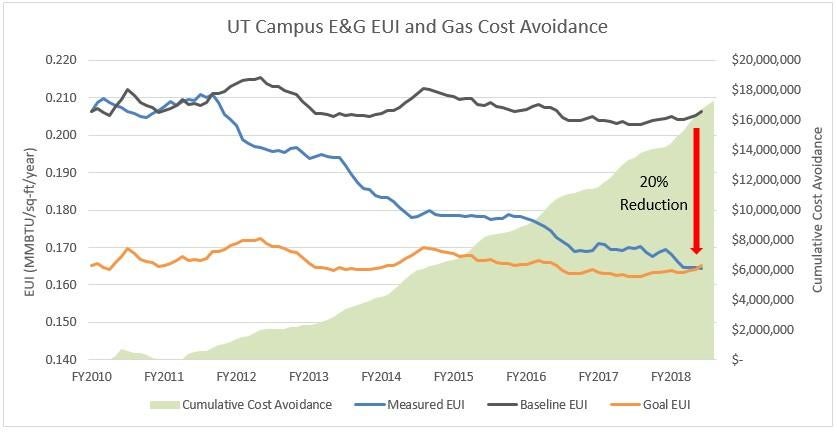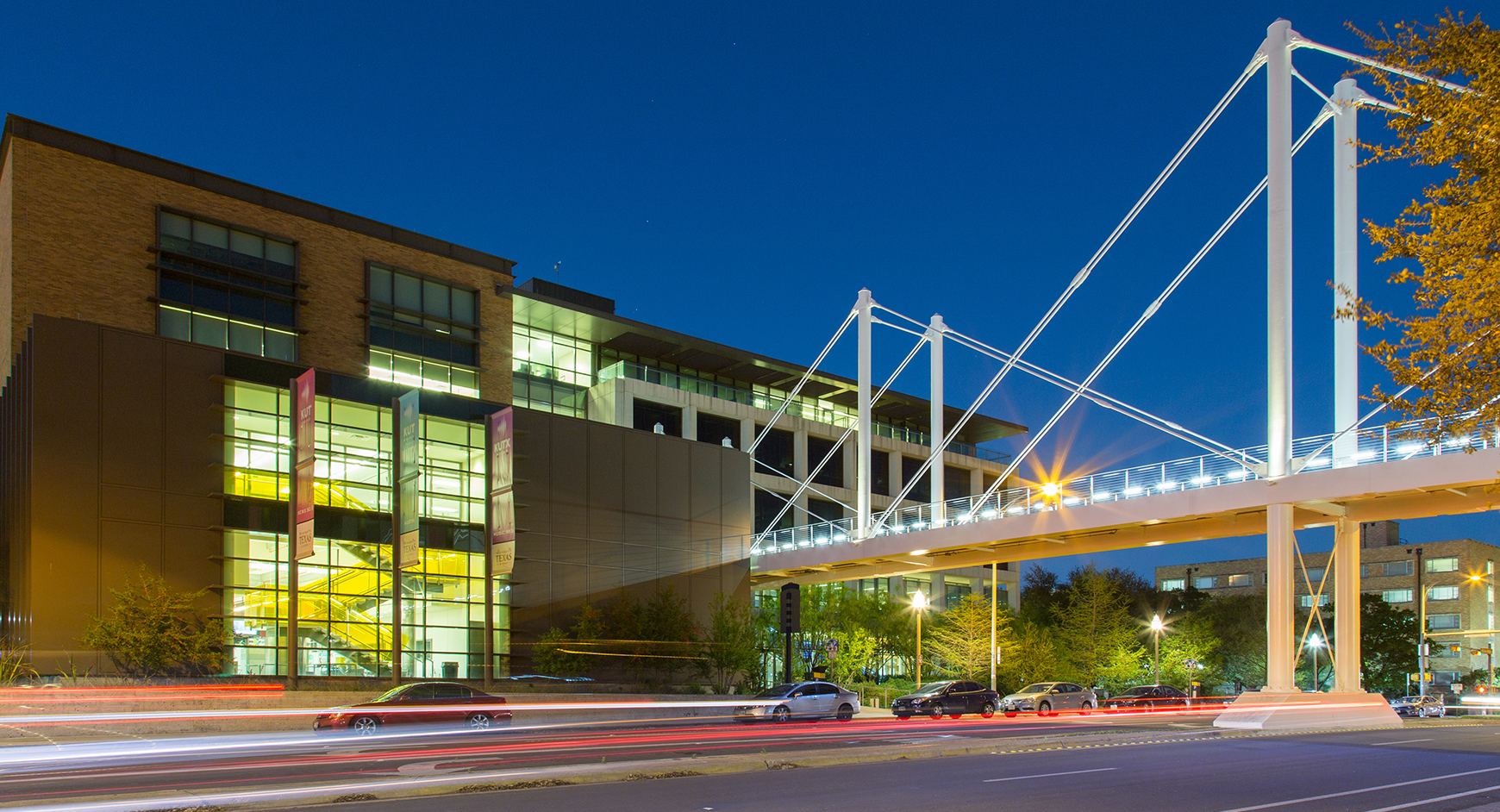A project at the Belo Center for New Media drastically cut energy consumption.
Image courtesy of Moody College of Communication
The University of Texas at Austin is an energy star. In a mere six years, an enthusiastic team of employees has slashed 20% from annual energy use intensity* in campus buildings, saving a cumulative $17,270,928 in fuel costs.
What is extraordinary is that the 17 million saved in avoided costs is an underestimate and not comparable to what people receive on their utility bills, or a fully burdened value. Since the 1930s, UT’s Carl J. Eckhardt Combined Heating and Power Complex—one of the most efficient power plants of its kind in the world—has purchased natural gas to generate its own electricity at a cost of roughly one third of a fully burdened value.
“Our team met the 2020 goal almost two years early!” says Roberto Del Real, associate director of Energy Management and Optimization (EMO). “By the use of measurement and verification protocols, we are able to confidently state we have met our goal of reaching 20% in energy use intensity savings this last February and are now saving over $2,000,000 in avoided fuel costs each year since 2014 fiscal year.”
The push to save energy on campus started in 2011 when the President’s Sustainability Steering Committee settled on cutting one-fifth of energy consumption by 2020 using 2009 as the baseline year. This goal was part of a broader Natural Resource Conservation Plan, and a team was created to focus on energy management of building systems by working with Facilities Maintenance groups such as Zone Shops, Building Analysts, Building Optimization Team, and Engineering and Technical Support.
Initially, energy use was reduced on campus by creating a culture of conservation through several innovative programs, including Longhorn Lights Out, a student organization that has saved about 174 megawatt hours in five years; Horns Up, Sash Down, a competition among labs since they typically consume 30% of campus energy; and HERO, a quarterly energy savings competition among maintenance crews.
While these programs remain successful, the energy management team quickly realized that dramatic energy reduction could be realized only by optimizing the mechanical side of buildings. Heating, ventilation, and air conditioning (HVAC) systems consume the lion’s share of energy in buildings, so scheduling, adding digital controls, and optimizing these system by enhancing the control sequences have led to huge savings. Beyond HVAC, the team secured a variety of small grants from Green Fund, a competitive program that pools a tiny portion of each student’s tuition to support sustainable ideas and research on campus, to cover some of the initial costs for several lighting retrofit projects as well as student engagement.
“There are two paths to save energy with existing buildings,” explains energy steward Meagan Jones. “The first is hard to quantify: everyday monitoring and maintenance. The second path is through focused projects that optimize HVAC systems and upgrade lighting.”
To date, 21 projects have been completed in buildings that average a 23% reduction in total building energy use and almost $50,000 in annual avoided fuel costs per project. An example of a project is in the Gates Dell Complex: after modifying the control sequences of the HVAC system, this building gained 40% in energy savings, or $103,000 per year in fuel costs. Similarly, completion of an air handling project in the Belo Center for New Media saved $20,000 per year.
Other projects have led to less dramatic energy reduction but provided tangible benefits. Replacing 5,175 lightbulbs with LEDs in the Perry-Castaneda Library saves just over $15,000 in fuel costs each year, but two hidden benefits emerged, including less time needed from maintenance crews because of longer-lasting bulbs as well as a refurbishment of the fifth floor.
In another example, the teaching lab fume hoods in the Norman Hackerman Building were put on a hibernation schedule when classes were not in session, saving $22,000 annually in fuel costs. Focusing on energy conservation in laboratories is important because labs consume more than twice the energy consumed by classrooms or office spaces.
“Every building is unique,” says campus energy manager Adam Keeling. “We pick opportunities by looking for buildings that have higher than expected energy intensity based on building type as well as having a suitable level of digital control that allows us to apply better building controls sequences and achieve improved performance.”
Currently, 18% of buildings have full digital controls, and 78% have partial controls.
“The work of the energy management team has saved the university millions, which means that our power plant—which is doing its own work toward optimal efficiency—will continue providing excellent service to campus as square footage increases,” says Juan Ontiveros, associate vice president for Utilities, Energy & Facilities Management. “Our new goal is to continue this work with a 2% reduction in energy use in campus buildings per year.”

The graph above shows the 20% energy intensity reduction of campus E&G (non-auxiliary) buildings from a baseline using 2009 campus energy data. The difference between modeled (grey) and actual (blue) energy usage reached 20% in February 2018, meeting the campus 2020 energy goals outlined in UT’s Natural Resource Conservation Plan.
The observed energy reductions and cumulative energy cost avoidance of $17,270,928 are a result of combined efforts between EMO, Facilities Maintenance, Project, Management and Construction Services, building occupants, and the construction of more energy efficient buildings.
__________________________________________________________________
* Energy use intensity (EUI) calculates energy use based on the building's size and function. For more information about energy use on campus, please check the energy portal.
Author: Kristin Elise Phillips, Communications Coordinator, Office of Sustainability

